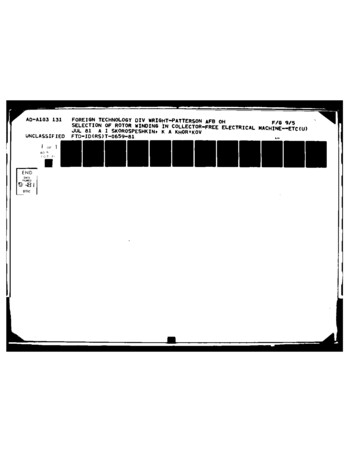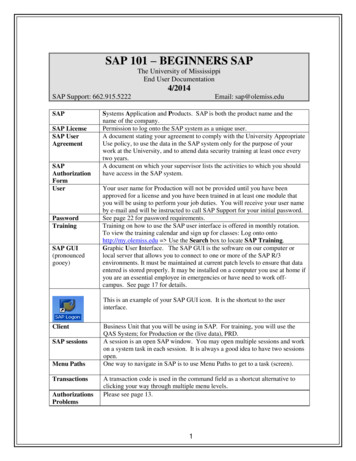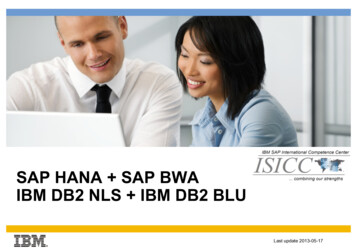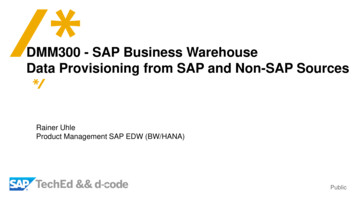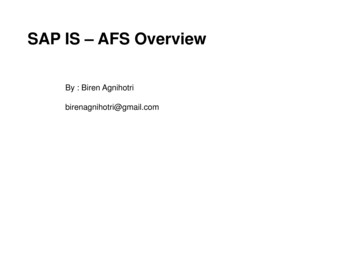
Transcription
SAP IS – AFS OverviewBy : Biren Agnihotribirenagnihotri@gmail.com
SAP ModulesSD : Sales & DistributionMM: Material ManagementWM : Warehouse ManagementFinancePP : Production PlanningFI : Financial AccountingFI-AM : Assets ManagementCO : ControllingPS : Project PMISHRQM : Quality ManagementPM : Plant Maintenance
Master Data in IS-AFSVendor MasterPartner MasterCustomer HierarchyVendor EvaluationPricing ConditionsConditionsRebate agreementsMaterial MasterQuota AllocationPre-packSeasonsEAN/UPC NumberingCharacteristicsDelivery program(Season/collection/Theme)Material gridAFS two-date pricingVendor Capacity PlanningVendor MasterBank MasterRoutingCost CentersWork CentersCapacityScheduling DataAFS Factor priceNRF CodificationPolitical Restriction MasterCustomer MasterFixed AssetsCharacteristicsPricing-AFS(J3AP, J3AX,J3AD)EAN/UPC NumberingBill of Materials (BOM)Packing instructionMaterial GridsPricing-AFS(J3AP,J3AX,J3AD)Material Master - MRP dataValue Added Services informationSeasonsVendor CapacitiesProfit CentersAFS Category Structureand Coverage StrategyAssortmentMaterial MasterSource ListG/L AccountsCustomer Material InformationInfo Record MasterService ConditionsAFS GridsCost ElementsActivity TypesStatistical Key FiguresInternal OrdersDistribution Profiles forPresizingCO-PA Master dataTransportation zoneCredit management master dataAFS DiscontinuationConsolidation Units
(1) Dimensions are defined as characteristics, with characteristics group/AFS/SAP-D(2) Characteristic values are maintained in the same transaction (CT04).(3) You can define ‘Relevancy’ of each characteristic for various applications thatallows data maintenance for each of this applications(4) It is mandatory to maintain the characteristic values to be used in a grid.(5) National Retail Federation (NRF) size and color codes may be assigned to thedimension in customizing from the particular grid.
(1) A material grid is a data construct that allows us to enter dimension informationfor materials(2) Dimensions within the grids are used to represent attributes of products, forexample, color, size, style.(3) Up to three dimensions are possible, for example, color, waist, inseam.(4) Dimensions can be up to eight characters long (for up to three dimensionscombined).(5) Dimensions can be numeric or alphanumeric.
There are three types of material grids:(1) Master grid:Part of the material master(2) Purchase grid:An application grid that is a subset of a master grid(3) Sales grid:An application grid that is a subset of a master gridThe order of dimensions may be sorted for use in the applications.Grid dimensions may be converted, for example, for use in a different country.
(1) Your products may have several attributes, so careful planning must go into the decision regardinghow you will set up your dimensions in the master grid.(2) You need to decide how many dimensions to assign to your material grids.(3) You must also decide which dimensions you will represent in your product.(4) If you create three-dimensional grids, one of them must be represented by a button. The examplesdisplayed above have “Color” represented as the 3rd dimension.(5) You can create one grid and then use it for several materials.(6) You can create an initial grid and use it as a reference grid for creating new grids. The relationshipbetween the grids is maintained.(7) Once a master grid has been saved it is possible to add more dimension values at any time. You canonly delete matrix values if the grid has not been used in any material. It is not possible to deletedimension values once entered.(8) Grids no longer used in any material may be deleted.
Purchase and sales grids complement master grids in that a relationship among customers,materials, vendor and users can be established for explicit control via the conditiontechnique.Example: If a vendor can only provide a limited range of sizes or colors, a purchase gridcan be created specifically for that vendor excluding those particular sizes or colors. Inpurchase order entry, these sizes/colors will not be displayed as valid for purchasingpurposes. However, it is important to keep the following constraints in mind: Purchase andsales grids are always a subset of a master grid. It is not possible to add or delete existingdimensions from a purchase / sales grid. If cells are deactivated in the related master grid,they are deactivated in the associated purchase/ sales grid.
The decision of whether to define material characteristics as griddimensions or categories requires careful planning. AFS providesinformation in addition to the material master. The master grid allows theaddition of multiple dimensions. It is not necessary to have a separatematerial master number for each individual characteristic. Coveragestrategy allows you to include stock and requirement categories. It alsoallows you to define strategies for PIR consumption, Stock toRequirements mapping in MRP/ATP/ARun functionalities at the categorylevel.
Categories provide an additional layer of detail that allows you to further specify or characterize yourproduct. You can create categories to segregate customer segments, levels of quality, country of origin, etc.For example, one of your categories might be Quality which might be defined at two levels. Quality 1would be your first grade goods, Quality 2 would be your second.The structure of categories can be freely defined by customer. The definition of categories is optional.Categories are linked to the material master via assignment of the coverage structure and strategy.Multiple category field structures, dynamic category content and application relevance are available.
The industry sector determines to which industry the material applies.This attribute decides: Which views are displayed and in which order What industry-specific data is displayed.The material master is the foundation for all logistics functions of the SAPERP System. One material master record is created for each material in thesystem.
Specific AFS views:1. AFS Basic Data2. AFS Sales Data3. AFS MRP4. AFS Warehouse Management 15. AFS Quality Management6. AFS ValuationSome Standard ERP views have been changed, e.g.,:1. Basic Data 22. Purchasing3. Accounting 1
Once this status has been flagged, the master grid cannot be replaced Master Grid: The master grid is used to define dimensions for a material. Aseparate material master for each size is not necessary Grid Determination Procedure: Grid determination procedure defines how agrid in SD or MM is selected for the specific material (condition technique) Assign the category structure and coverage strategy for the AFS material
The seasons of business (spring/summer, fall/winter, back-to-school, Christmasetc.) requires that certain products be available for their corresponding season, withspecial needs to “mark down” or “move” inventory that will soon be out of season. Seasons are supported in AFS Sales and Distribution. Seasons are supported inAFS Materials Management and Production from AFS 5.0 onwards. The season control function enable a full control in the sales order process of theordering opened dates and the delivery opened dates.
In AFS there are two types of BOMs:1. AFS Standard BOM2. AFS Assortments3. AFS Pre-packs are part of the standard BOM.Pre-pack and assortment BOMs are used in SD only.
A pre-pack is a set of predefined combinations of quantities and sizes in the BOM structure.The header material may contain a master grid that is different from the grids of thecomponents. All items, independent of their levels in the BOM, are MRP relevant.If a material is used as header material in a pre-pack, it needs to be defined as a regularAFS material.For example, a golf pack will always consist of a shirt, pants and cap in the sizes relating toa size of the header material.
An assortment is usually put together at the request of the customer whereby the quantity and sizes ofthe set may vary but not the items within the BOM structure. A set material BOM is the same concept asa phantom assembly in the standard system, in that the header material is merely a grouping of two ormore finished products. The header material contains no master grid but may have categories. Thecomponents may have differing master grids. The sizes and quantities are allocated when the BOM isexploded after a sales order has been entered. The components are stock keeping items.If a material is a header material used in a sales BOM for an assortment, you must activate the Setmaterial field in the material master record. The material grids are defined in the material master of itscomponents.For example, a customer may want to have an assortment consisting of a golf shirt, golf pants, and golfballs. The header material has no grid. The golf shirt and pants have a grid but the golf balls are astandard material. You enter the requirements at SKU level when entering the sales order.
The AFS BOM includes the grid information for all components. Components may be either AFSmaterials or standard materials. You can view the master grid of the header material when working withany component, even if the component is a non-AFS material. Some features of AFS BOMs are: Dimension dependent consumption, e.g., the use of self for the jacket differs slightly for thevarious sizes. Dimension dependent components, e.g., lining is only needed for the white jacket. Dimension dependent dimensions , e.g., a black size 6 jacket will use a black 17 inch zipper. A black size 8jacket may use the same zipper, but a size 10 may need a 18 inch zipper.Furthermore AFS supports different reports for BOM explosion.1. Display a BOM level by level (TC:CS11) - This BOM reporting function shows which components make upthe individual assemblies across multi-level.2. Multi-level BOM (TC: CS12) -This reporting function determines all components (assemblies andindividual parts) in a product and displays them in their structural context for production.3. Summarized BOM (TC: CS13)
The typical procurement cycle for a service or material consists of the following phases:1. Determination of Requirements2. Source Determination3. Vendor Selection and Comparison of Quotations4. Purchase Order Processing5. Purchase Order Follow-Up6. Goods Receipt and Inventory Management7. Invoice VerificationThe purchasing documents are supported for AFS materials. You can maintain the gridvalues and categories in these documents.
The vendor master includes all data necessary for processing business transactions and correspondingwith vendors.Information is shared between the accounting and purchasing departments.Data is grouped into three categories:1. General data2. Accounting data3. Purchasing data (with AFS additional data)Vendor master records must be created before procurement can begin.For AFS vendors the Schema Group Vendor used is J1 (used to determine the AFS - specific pricecalculation scheme J 3A00)
Purchasing information records describe the supply relationship of a material and a vendor.The purchasing info record is a part of the master data for purchasing. It holds information for a specificmaterial and vendor combination.Information records allow the definition and maintenance of:1. Current and future prices and pricing conditions (for example, freight, discounts).2. Delivery data (for example, delivery lead time, tolerance limits)3. Information from the last purchase order and quotation4. Vendor dataData maintained in the information records appears as default values during the creation of purchasingdocuments (for example, purchase orders, contracts). The information record can be updatedautomatically from a purchase order, request for quotation or quote, provided that the informationupdate indicator in these documents is activated. Information records can be displayed individually,by vendor, by material, or by material group.
1. The replenishment lead times specify the lead time of the vendor to procurethe raw material.2. The manufacturing lead time specifies the production time of the vendor.3. The packing lead time specifies the lead time needed by the vendor toprepare the material for transshipment.4. The transportation lead time specifies the lead time to transport the materialfrom your vendor to your plant.
With the condition technique, you can create pricing conditions at SKU level.The conditions at SKU level are not maintained in the info record itself, but arecreated using Master data - Conditions - Other.You can maintain pricing conditions at different levels. For example:1. Material info record with grid value & category (plant-specific)2. Material info record with grid value & category3. Material info record with grid value4. Material info record with price group5. Material info record with category (plant-specific)6. Material info record with category
The transportation lead time for a route from your vendor to your plant can be determined in routedetermination. This function uses parts of ERP Standard route determination in sales and distribution,which determines the route from your plant to your customer. For the determination of the route, thezones of your vendor and your plant, shipping condition and transport group are taken into account.The transportation lead time for a route is determined and can be recalculated according to differentshipping conditions. For example, when the goods are normally transported, it is done by truck, butwhen the goods are urgently needed, the goods can be transported by plane. For these shippingconditions another route and transportation time is determined.The (re)determination of the route can de done by forward and backward calculation. By forwardcalculation the delivery date is recalculated. By backward calculation the delivery date is fixed and theproduction date, packing date and ex f
The material master is the foundation for all logistics functions of the SAP ERP System. One material master record is created for each material in the system. Specific AFS views: 1. AFS Basic Data 2. AFS Sales Data 3. AFS MRP 4. AFS Warehouse Management 1 5. AFS Quality Management 6. AFS Valuation Some Standard ERP views have been changed, e.g.,: 1. Basic Data 2 2. Purchasing 3.
